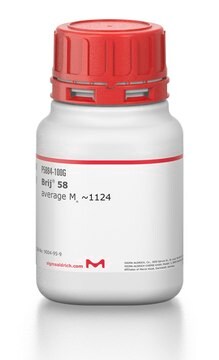STS0218
ECO Brij® S20
Sinonimo/i:
Brij® S20, Polyethylene glycol octadecyl ether, Polyoxyethylene (20) stearyl ether
About This Item
Prodotti consigliati
Descrizione
non-ionic
Livello qualitativo
Forma fisica
solid
Caratteristiche più verdi
Use of Renewable Feedstocks
Design for Degradation
Learn more about the Principles of Green Chemistry.
Impurezze
≤3.0% water
Punto di fusione
44-46 °C (lit.)
Numero di acido
≤1.0 mg KOH/g
Indice di ossidrile
45‑60 mg KOH/g
HLB
15.3
Categoria alternativa più verde
Stringa SMILE
CCCCCCCCCCCCCCCCCCOCCOCCOCCOCCOCCOCCOCCOCCOCCOCCOCCOCCOCCOCCOCCOCCOCCOCCOCCOCCO
InChI
1S/C20H41O2/c1-2-3-4-5-6-7-8-9-10-11-12-13-14-15-16-17-19-22-20-18-21/h2-20H2,1H3
PSEGVHKUPXNGGJ-UHFFFAOYSA-N
Cerchi prodotti simili? Visita Guida al confronto tra prodotti
Categorie correlate
Descrizione generale
Caratteristiche e vantaggi
- 100 % Renewable
- 100 % Bio-based
- Certified to the USDA BioPreferred Program
- Lower carbon footprint than petrochemical-based versions
- High-purity chemical suitable for a wide variety of research applications
Altre note
Note legali
Avvertenze
Warning
Indicazioni di pericolo
Consigli di prudenza
Classi di pericolo
Acute Tox. 4 Oral
Codice della classe di stoccaggio
11 - Combustible Solids
Classe di pericolosità dell'acqua (WGK)
WGK 2
Punto d’infiammabilità (°F)
Not applicable
Punto d’infiammabilità (°C)
Not applicable
Scegli una delle versioni più recenti:
Certificati d'analisi (COA)
Ci dispiace, ma al momento non ci sono COA disponibili online per questo prodotto.
Se ti serve aiuto, non esitare a contattarci Servizio Clienti
Possiedi già questo prodotto?
I documenti relativi ai prodotti acquistati recentemente sono disponibili nell’Archivio dei documenti.
Il team dei nostri ricercatori vanta grande esperienza in tutte le aree della ricerca quali Life Science, scienza dei materiali, sintesi chimica, cromatografia, discipline analitiche, ecc..
Contatta l'Assistenza Tecnica.





